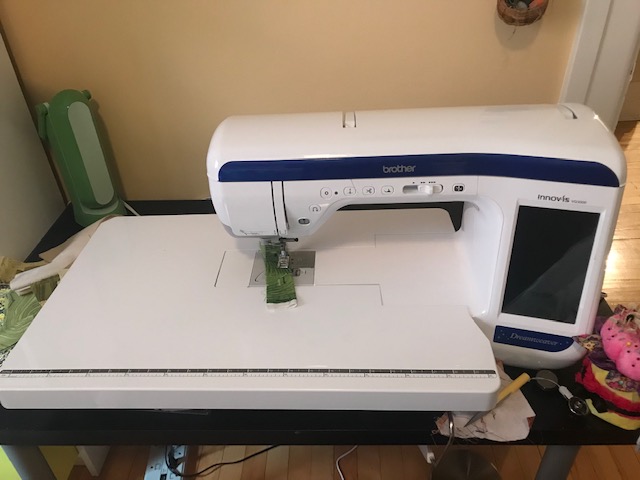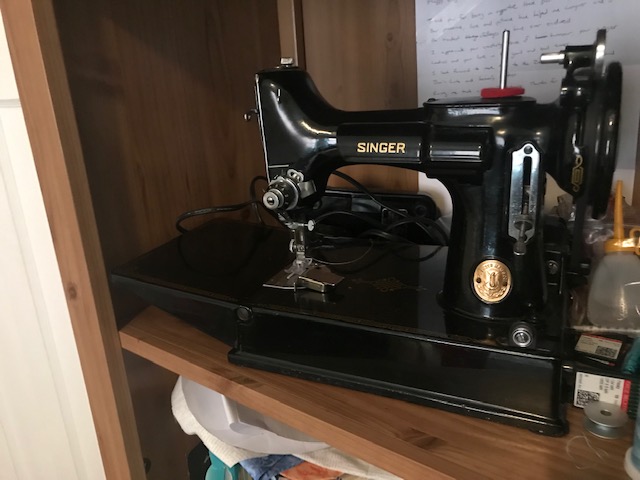When I was a teen, I didn’t know much about sewing machines. I used my mother’s old Pfaff machine from the Netherlands. We needed to use a transformer to plug it in to the outlet here in Canada. It was considered a portable machine, but darn, that thing was heavy!
When I struck out on my own, I bought a basic Singer sewing machine. I wasn’t an accomplished seamstress (I still am not. Cannot sew clothes for love nor money), but I wanted it anyway because I still would try to sew things from time to time. As my kids came along, I upgraded a bit to a Kenmore, also basic, and used it to sew Halloween costumes, cloth diapers, curtains, that sort of thing. It was about this time that I began quilting, so that was my first machine for piecing my quilt tops.
Sewing machines with embroidery module?
Soon, I went from a Kenmore to a Husqvarna and I went for one that had an embroidery module which I thought I just HAD to have. But it turned out that I didn’t really use it all that much, so after a while, I traded that one in for a bit better one without embroidery, a Lily I think it was. I liked my Husqvarna machines, they sewed well, no problems with them, but I didn’t like that they used proprietary pieces, right down to the bobbins. That meant I had to specially order everything and, of course, at a higher price. After a while, I decided that I didn’t want to do that anymore and I was also ready for a machine with a larger throat to give me more quilting space. Enter my Janome Horizon 8900.
The Janome was great. It cost more than I’d ever spent on any machine and, to be honest, I had an anxiety attack about spending that money. My husband encouraged me to go for it because, as he reminded me, I really use my machines. I don’t just buy them and look at them, only to use them occasionally. Don’t get me wrong, my husband doesn’t tell me what I can and cannot spend money on any more than I tell him, but his support helped me overcome the anxiety I was feeling about spending that money.
Sewing machine frustrations
I had a lot of fun with the machine once I figured out a few problems. For example, it hated a certain brand of thread. Every time I would use it, the thread snapped. I did some reading and I learned that other people had the same problem, so I just avoided that brand ever since. The machine gave good even stitches, had lots of space, so many stitches, and it had a 9 mm wide stitches, which I loved. But – and it was a big but – the machine did not like thick seams.
Every time I would forget and sew over a big seam, the timing would go off and it was another service call to get it fixed. Since I also like to sew bags and purses, this was not something I could continue to live with, so I sold that one. One woman contacted me to buy it and said she was looking to buy a machine that would allow her to sew bags out of jeans. I told her that this wasn’t the machine for her, and this was precisely why I was selling it. I had to be honest with her. In the end, it went to a quilter who wasn’t planning on using it for anything else.
My newest sewing machine
My most recent sewing machine is a Brother Q3000. It sews like a dream, doesn’t mind the thick seams, and I really like it. The stitches can only go 7 mm wide, but even though I liked the 9 mm ones with the Janome, really – how often did I use that function?
I also have a 1949 Singer Featherweight machine. I remember in the past reading posts online from quilters who loved their Featherweight sewing machines. Some have several. I couldn’t understand the attraction – after all, it was a sewing machine that could only go forward and back. But then I had the opportunity to buy one that had been fully restored and oh my. Now I know why quilters rave over them. It’s so much fun to piece quilts with this machine. The stitches are so consistent and straight, it’s just a pleasure to work with.
Shopping for sewing machines
If you are in the market for a machine and you’ve never bought one before, there are some things you should keep in mind while you shop:
How much money can you spend? You don’t need an expensive machine with all the bells and whistles, especially if you’re a beginner or just above. But I do recommend you buy the best you can afford. I usually discourage people from buying the cheapest models because they can be difficult to work with. And if you’re just learning how to sew or quilt and you run into problems, it will suck the fun right out of it. You may think that sewing or quilting is harder than it really is.
Do you have shops nearby? The best way to choose a machine is to try out as many as you can. Shops that sell machines will have some set up for you so you can sit down and sew, get a feel for the machine. If you want to sew something specific, you can bring a fabric sample with you. For example, because I knew my Janome hated thick seams, when I went to test drive the Brother, I brought some fabric with thick seams with me to see how the Brother would manage it.
How complicated is the machine? Some sewing machines are all mechanical, some are electronic. Mechanical machines, like the Featherweight, are fairly easy to maintain and repair. I work on my Featherweight myself using YouTube videos if I’m really stuck. But, mechanical machines are limited in the different features they offer. Electronic machines often offer many embroidery stitches, buttonholers, and more. But, if they malfunction, chances are you will need to pay a technician to fix it and repairs can be pricey.
You can buy machines second-hand. Many people sell their machines if they feel they’re not using them, they’re downsizing, or someone is clearing out an estate. The prices may be good, but you still need to try out the machine before committing. Does it work? Does it have the manual still? How often was it serviced? Check the brand reviews online and see what others say about the machine.
Use your machine!
I have one more piece of advice. If/when you buy your machine – use it! I’ve heard too many stories of women buying a lovely, often expensive machine and never, ever used it. Some are too scared to use it, afraid they’ll break it or not be able to master it. I’ll tell you a secret – if I can learn how to use a sewing machine, you can too. And yes, you’ll probably mess up the first few times. Or more. You may thread it incorrectly, not wind your bobbin correctly or break a few needles. These are all fixable. And when you make these mistakes, the chances of making them later are slimmer. But they’ll still happen. I broke two needles last week. One, I put the wrong foot on for the stitch I was using. Oops. The other just broke. No idea why. It happens. And we move on.


